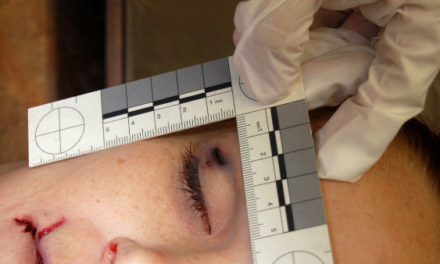Intro
“Hannah Upp’s colleagues at the Montessori School in St. Thomas immediately knew something was wrong when she failed to show up to a scheduled staff meeting on the morning of September 15, 2017.
People had seen Upp, but nobody had communicated with her through text or telephone in three days. That’s when her close friend, Maggie Guzman, began calling around in search of the 32-year-old teacher gone missing and was given the cryptic direction to ‘look by water.’ What Hannah Upp’s friends and colleagues in St. Thomas didn’t know is that it wasn’t the first or second time that she had gone missing.”
Tate Delloye, DailyMail.com, 5/16/2019
People’s minds checking out before they “check out of the hotel” isn’t all that new.
But we’ve never encountered a case quite like Hanna Upp’s. Never.
She’s one remarkable young woman. If she’s even still with us, which no one can say for sure as we write this in the winter of 2021.
Hannah is a young US-born American woman whom everyone always described as normal, cheerful, outgoing, and smart. Her childhood seemed free of any specific trauma or abuse.
Her parents are educated and interesting people.
She did travel the world in her youth…
And she did disappear, three times. And when we say, disappear, it appears she even disappeared from herself. Which begs the question, what is a (the?) true self?
Her first disappearance was almost her last–she was found floating, face down in the water, off Staten Island in New York. She was starting a school teaching job in Harlem at the time. Astonishingly, she was revived, although sunburned and the worse for wear.
Five years later she disappeared, from the world and from her own identity, again. Also as a new school year was beginning, in September. Again, water–she was found at the edge of a creek, in “Hannahland” you could say, but “woke up” upon being found and was confused and apologetic. Just “woke up,” and called her mother.
Finally in 2017, again, it was September, she was teaching in the Virgin Islands at a Montessori School. And Hurricane Irma came through, devastating all in its path. With another storm in the forecast, due to arrive soon.
She survived the crushing hurricane, but days later her car and keys were found near a local port. Her car and personal effects were found, but never Hannah.
She was never to be seen again.
The Life of Hannah
Why did Hannah go off to become a “fugue-ative,” if you will, on more than one occasion?
Her mother experienced a brief dissociative episode years before, and there may be a hereditary component. Yet that has to be only a small part of the picture.
Hannah grew up happy and healthy, it would seem, more comfortable and blessed than most of the people on the planet, to educated parents who steered their life by a religious compass.
Her mother, an ordained Methodist Minister, became more and more interested in open, searching religions as she aged, finally becoming a Quaker. “Friends” in this style of faith convene in meetings where silence reigns–but anyone can raise a voice out of that silence if the spirit moves them–and thus their comments are a sort of ministry.
No formal pastors lead the services, but one wise old Quaker said–”We haven’t abolished the ministry. We’ve abolished the laity.”
Thus the faith of Hannah’s mother sprang freely from a non-judgemental God. She was much more open than Hannah’s father–more accepting of different lifestyles and ideas.
Hannah’s parents had divorced when she was 15 years old, perhaps partly due to their religious differences and certainly their views of the world. Perhaps significant is the report that her mother had experienced at least one dissociative episode while she was taking medication. There is a hereditary component to dissociative tendencies.
Hannah had been fashioned by a religious home– her parents were “clergy.”. She traveled the world with them, often on religious missions. Her father lived in India at the time of her first disappearance, where he taught Seminary. He was rigid in his beliefs, essentially a fundamentalist. He accepted the word of God as literal.
Hannah was, at first, a Creationist, she had also joined an Evangelical campus group in college. She appeared to be of high intelligence and she spoke Japanese. (High intelligence is another factor in the ability to dissociate.)
Hannah’s favorite author later became Isabel Allende, especially her novel “El Plan Infinito.” The book is about a hero who spends decades wrestling with the teachings of his father who, like Upp, became an itinerant preacher traveling from place to place.
According to friends, Hannah was an open-hearted and kind person who would give to others until there was “nothing left of her”. She was one of those people that would light up the room and was everyone’s best friend. She had no barriers. Friends also said she lived in “Hannah land” where there were butterflies and birds and all is good and everyone is happy and there is…no conflict, ever.
She had a Hindu friend who asked her “Do you think I’m going to hell?” Hannah cried at the thought of her friend going to hell because of her beliefs. In her second year of college she heard a Methodist minister speak of how she had been defrocked because she was a lesbian. Hannah thought that part of the faith was cruel.
(Her father believed there was “no such human as a natural homosexual” as he considered it sexual perversion.)
By the next year Hannah was dating a woman. Then, like her mother, she became drawn to Quakerism. Yet she still traveled with her father every year to wherever he was teaching. A friend said that he “wondered how Hannah swallowed a part of herself down while with her father.” Could it be that fear of her father’s disapproval led to psychological tension-eventually disconnect–in Hannah?
The Disappearances
NY- September 16, 2008 , age 23
First Disappearance:
September, always September, it turns out. Hannah was about to begin teaching school in Harlem the day before she disappeared. She left her apartment for a run. She took nothing with her. She started her run around Chelsea Pier, where she had been previously to attend a 911 memorial with Japanese lanterns. She had also danced at an Obon festival with the same kind of lights which represented departed souls. She said that there was something soothing about the water. It was a full moon. Was she drawn, almost hypnotically, to the softness of the alluring scene?
During the three weeks she was missing she logged into her facebook account from an Apple Store but left right away. Someone recognized her once and asked her if she was Hannah Upp. She vehemently denied that she was. She had been spotted at gyms, apparently to shower, and at a Starbucks. Where she had been in between, no one knew. Finally she was found off of Staten Island, face down in the water by fishermen who thought she was dead. Apparently she had jumped into a kayak and paddled, then swam to a nearby island where she slept or passed out, leaving her with a severe sunburn on one side of her body. Who knows how long she lay there or how she got into the water before she was spotted.
She was given extensive physical and psychological testing after the episode and no head injury was found to explain the events. She had been given the Myers Briggs personality test at one point in her life and was found to be an Extrovert, Intuitive, Feeling, Perceiving personality. The latter three dimensions of her personality speak to how deeply she may have felt things and why, perhaps, she would need to push down some intense feelings, or “run away from them”.
The conclusion of her psychological exam was that she had experienced Dissociative Fugue. In layman’s terms this is a disorder in which a person suddenly has amnesia for facts about themselves and their history. It can last for hours, up to years and can reverse just as suddenly. In therapy (including hypnotherapy) she was not found to have experienced any severe trauma. This was confirmed by Hannah and her family. So what caused the fugue episodes?
Missing Again
Maryland- September 2013, 5 years later.
Second Disappearance:
We know less about the details of the subsequent disappearances, but some similarities were unmistakable. Again a new school year was starting and she was set to teach at a Montessori school. Again, she left her wallet and phone at home and was apparently drawn to water. This time she went to a creek. She was texting and after a while looked down at what she was doing and didn’t remember texting.
She “lost track of time,” perhaps the beginning of losing track of herself. She had been missing for 2 days this time when she was found laying in a creek near some roots. She “woke up” and called her mom. She said that she felt embarrassed and guilty even though she didn’t do anything to cause these episodes. Imagine her anguish, causing all this worry to her friends and family a second time without understanding what was happening to her.
She moved a year later, perhaps to give herself a fresh start.
Missing For Good
Virgin Islands- September 2017, 4 years later, 32 years old.
Third Disappearance:
The calamity of the hurricane in the Virgin Islands in 2017 would have shaken anybody, and it certainly did Hannah. And came at her vulnerable time, September, the start of school. With the school building, like everything else, in shambles, life would be up in the air for all those kids, all those teachers.
Hannah disappeared, and her close friend, Maggie, thought, well it won’t be hard to find her.
(They also often) adopt a new identity (and) suddenly embark on a long journey. The state is typically triggered by trauma, a natural disaster or “by an unbearable internal conflict.”
Stephanie Nolasco, 5/16/2019, FoxNews.com
After hurricane Irma, when others were leaving the islands, Hannah told friends she wanted to stay and try to get the Montessori school up and running. She wanted to give the kids some consistency especially after the trauma of the overwhelming storm. Her friends said she seemed happy…but “trance-like.”
Note those words: “trance-like.”
In the aftermath of the storm, she had texted friends around the world to let them know she was safe but at the same time she didn’t seem to recognize anything around her. It was as if this was a new, unfamiliar place, not her home. Still she was happy.
One day she went to the water. Again, she left everything in her car including her folded clothing, and again she was last known to be at the sea; Sapphire Beach. Was there a hidden trauma, hidden even to her, that involved water in September? Was she trying to escape that memory?
That was the last time anyone heard from her.
Highway Hypnosis and the Rest of Us
We all disconnect at times. We all have different “hats” we wear in different life situations as well. People behave somewhat differently, sometimes very differently, when at work as opposed to with their children or partner. (Ethel Cardena- a Swedish Professor of Psychology said that In modern cultures we have a nice narrative that personality is stable – but that’s merely comforting fiction, she maintains.)
There are a range of Dissociative Disorders, from mild like this to severe, even very severe such as multiple personality disorder.
Dissociative states have been studied for over a hundred years. One of the founding fathers of psychology, French Psychologist and physician, Pierre Janet (1907) said of fugue states that they are a construction of awareness such that complex behavior responses (automatisms) are executed outside of the conscious awareness and control. He cited the case of a patient, Irene, who was amnesic during her mother’s illness and death, running on a sort of psychological auto-pilot.
The Merck Manual of diagnosis and therapy describes the disorder this way. “Fugue is one or more episodes of amnesia in which the inability to recall some or all of one’s past, and even the loss of one’s identity, occur with sudden unexpected purposeful travel away from home.“
Dr. Philip Coons, a contemporary psychiatrist, stresses that “Fugue can last for hours to years. It is usually triggered by a traumatic event and is not always reversible. It is a ‘running away’ from a bad situation often with documented travel or wandering across continents.”
Dissociative Fugue can be fairly benign and last only for hours, or very severe and last for years. While uncommon, some stories are striking: someone disappears years ago from Ohio, USA, and resurfaces twelve years later (under another name, thinking they are another person) in London. Mind-boggling, but true.
This type of dissociation is quite rare, usually with adolescence or early adult sudden onset. Some believe there is solace in fugue. It is most common with victims of childhood sexual abuse with a developed ability to dissociate from the memory of the abuse.
Those in a fugue state have amnesia for their biological data while in the state and generally amnesia for the events that occurred while in fugue after it is over. This does sound like Hannah, except . . . was there abuse that is still unknown? And what’s the connection to water and September?
Reflections on Tragedy and Mystery
Leading to the theory, advanced by some, that Hanna has rather purposely disappeared and reinvented herself, somewhere. A fresh chance at life.
If that were the case, she likely would have read her mother in, and her mother would not have spent so much time and money searching for her daughter, high and low in the Caribbean.
Or would she have communicated with family? Who can really say what drives the human psyche.
It does seem extremely likely that Hannah dissociated again after Hurricane Irma. The elements were all aligned–September, school, with additional trauma, stress, and a mercurial situation in which people were leaving the island in droves after the hurricane.
It’s the perfect storm, no pun intended, for a stress-induced departure from self.
What we don’t know, as of this writing in late 2021, is precisely what happened. No trace of her has been found. We don’t know if she’s still alive.
Fugue, this time, has left nothing behind but mystery.




